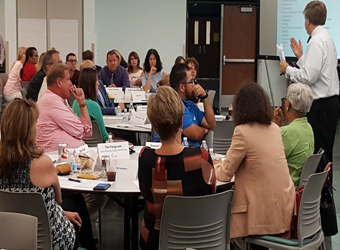 To tackle complex challenges like rising postsecondary completion rates communities recognize that no one institution can solve the problem alone.
To tackle complex challenges like rising postsecondary completion rates communities recognize that no one institution can solve the problem alone.
FCAN’s Kathy McDonald, Assistant Director for Network Partnerships, was recently joined by guest presenters Liz Weaver, Co-CEO of the Tamarack Institute and leader of the Tamarack Learning Centre, and Lisa Church, Vice President of Champions For Learning and leader of Future Ready Collier, for a webinar exploring the growing number of communities taking a collective approach following the framework articulated by John Kania and Mark Kramer of FSG in a 2011 article published in the Stanford Social Innovation Review entitled “Collective Impact.”
Since that time, community change experts have built on the framework to include other elements that are important in driving system change around a complex problem.
The Evolution of Collective Impact
Liz Weaver shared the highlights of Tamarack’s “Collective Impact 3.0: An Evolving Framework for Community Change,” a whitepaper that defines the next evolution of collective impact:
From a management paradigm to a movement-building paradigm: This shift encourages bringing in a broad and diverse group of leaders, especially those not in the traditional seats of power, to focus on opening hearts to new possibilities in changing seemingly intractable systems.
From common agenda to community aspiration: This shift inspires communities to consider the shared values that are sufficiently ambitious enough to require moving beyond business as usual. It helps the community move beyond just a strategic plan to build excitement and commitment among participants.
From shared measurements to ones that foster strategic learning: This helps the community make sense of what is and isn’t working, and necessitates evolving strategies based on learnings along the way.
From mutually reinforcing activities to high leverage and systems focus: Shifting the lens from moving a community’s activities in the same direction to one focused on those activities that can drive the biggest impact allows limited resources to be used where it can make the greatest difference. This offers the ability to scale more quickly as promising practices show impact.
From continuous communication to authentic community engagement: This shift puts community at the center of the process and allows the community to get a 360 degree view of the challenge. Those impacted by an issue engage fully in crafting solutions.
From backbone infrastructure to container for community change: As containers for change, community change leaders facilitate the partners’ inner journey of change while developing trust and empathy. These leaders also recognize the need for timely nudges to sustain momentum.
Collective Impact 3.0 in Action
Lisa Church then shared a couple of examples of Collective Impact 3.0 in action. Movement building and community aspiration were on display as she discussed the community’s response to Hurricane Irma, where leaders had to come together and quickly shift strategies to meet pressing recovery needs. She also shared how they are deepening their authentic community engagement through the launch of their new Parent Cafes that help children by building community and support among parents.
The LCAN Difference
Through Collective Impact, Florida communities supported by LCANs saw FAFSA completion rates 10 points higher than communities that are not supported by an LCAN last year. To learn more about Collective Impact, listen to the webinar recording and check out Tamarack Institute’s resource library. You can find additional resources at CollectiveImpactForum.org.
Show Notes:
Recording
Slides
Tamarack Institute’s white paper
Future Ready Collier report
FutureMakers Coalition case study
How LCANs are different than a task force
Be sure to visit our Past Webinars page for access to recordings and downloadable material from FCAN’s previous presentations.
